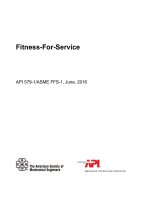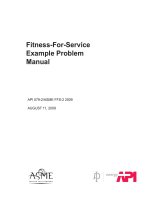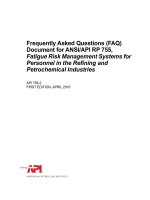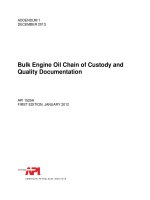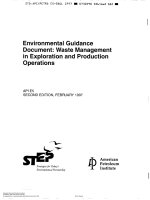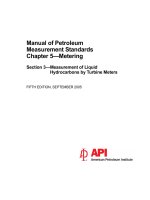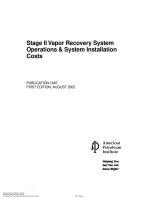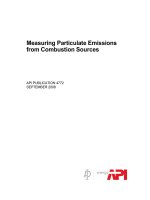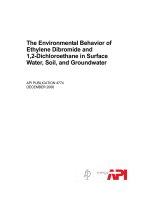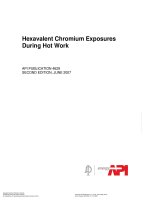Api publ 4734 2005 (american petroleum institute)
Bạn đang xem bản rút gọn của tài liệu. Xem và tải ngay bản đầy đủ của tài liệu tại đây (3 MB, 146 trang )
Modeling Study of Produced Water
Release Scenarios
API Publication Number 4734
January 2005
Modeling Study of Produced Water
Release Scenarios
Regulatory Analysis and Scientific Affairs Department
API Publication Number 4734
January 2005
PREPARED UNDER CONTRACT BY:
Jan M. H. Hendrickx, Department of Earth & Environmental Science
New Mexico Tech, Socorro, New Mexico
Graciela Rodriguez, R.T. Hicks Consultants, Ltd., Albuquerque, New
Mexico
Randall T. Hicks, R.T. Hicks Consultants, Ltd., Albuquerque, New Mexico
Jirka Simunek, Professor and Hydrologist, Department of Environmental
Sciences, University of California Riverside, Riverside, California
SPECIAL NOTES
API publications necessarily address problems of a general nature. With respect to
particular circumstances, local, state, and federal laws and regulations should be
reviewed.
Neither API nor any of API’s employees, subcontractors, consultants, or other assignees
make any warranty or representation, either express or implied, with respect to the
accuracy, completeness, or usefulness of the information contained herein, or assume
any liability or responsibility for any use, or the results of such use, of any information or
process disclosed in this publication, or represent that its use would not infringe upon
privately owned rights.
API publications may be used by anyone desiring to do so. Every effort has been made
by the Institute to assure the accuracy and reliability of the data contained in them;
however, the Institute makes no representation, warranty, or guarantee in connection
with this publication and hereby expressly disclaims any liability or responsibility for
loss or damage resulting from its use or for the violation of any authorities having
jurisdiction with which this publication may conflict.
API publications are published to facilitate the broad availability of proven, sound
engineering and operating practices. These publications are not intended to obviate the
need for applying sound engineering judgment regarding when and where these
publications should be utilized. The formulation and publication of API publications is
not intended in any way to inhibit anyone from using any other practices.
Any manufacturer marking equipment or materials in conformance with the marking
requirements of an API standard is solely responsible for complying with all the
applicable requirements of that standard. API does not represent, warrant, or guarantee
that such products do in fact conform to the applicable API standard.
All rights reserved. No part of this work may be reproduced, stored in a
retrieval system, or transmitted by any means, electronic, mechanical,
photocopying, recording, or otherwise, without prior written permission from
the publisher. Contact the Publisher, API Publishing Services, 1220 L Street,
N.W., Washington, D.C. 20005.
Copyright © 2005 American Petroleum Institute
FOREWORD
Nothing contained in any API publication is to be construed as granting any right, by
implication or otherwise, for the manufacture, sale, or use of any method, apparatus, or
product covered by letters patent. Neither should anything contained in the publication
be construed as insuring anyone against liability for infringement of letters patent.
Suggested revisions are invited and should be submitted to the Director of Regulatory
Analysis and Scientific Affairs, API, 1220 L Street, NW, Washington, DC 20005.
ACKNOWLEDGMENTS
API would like to acknowledge the following people for their contributions of time and
expertise during this study and in the preparation of this report:
API STAFF CONTACTS
Harley Hopkins, Regulatory Analysis and Scientific Affairs Department (RASA)
Terry Twyman, Upstream
MEMBERS OF THE PRODUCTION WASTE ISSUES GROUP (PWIG) AND THE PWIG
BRINE WORK GROUP:
Evan Sedlock, ChevronTexaco Energy Technology Company; PWIG Chairman
Jeffrey Adams, BP America, Inc
Mickey Carter, ConocoPhillips Corporation
George Deeley, Shell Global Solutions (US) Inc.
Neal Goates, ConocoPhillips Corporation
Jill Kerr, Exxon Mobil Corporation
Rosemary Martinez, BP America
Greg Minnery, ChevronTexaco
Sam Small, Amarada Hess Corporation
Mike Starrett, Oxy Permian
Appreciation is extended to Carolyn Haynes of Rice Operating Company for providing
funding for the field verification of the modeling.
Modeling Study of Produced Water Release Scenarios
TABLE OF CONTENTS
Table of Contents.................................................................................................................................................. i
Executive Summary............................................................................................................................................. v
Technical Highlights ........................................................................................................................................ viii
1.0 Introduction ................................................................................................................................................. 1
1.1Project Overview......................................................................................................................................... 1
1.1.1 Research Objective .......................................................................................................................... 1
1.1.2 Project Organization ....................................................................................................................... 1
1.1.3 Scope of Modeling ........................................................................................................................... 1
1.2 Background .............................................................................................................................................. 3
1.2.1 Fulfilling an Industry Need............................................................................................................. 3
1.2.2 Potential Impacts of a Release ....................................................................................................... 4
1.2.3 Common Soil Restoration Programs ............................................................................................. 4
1.2.4 Restoration of Chloride in Ground Water ..................................................................................... 5
2.0 Factors Influencing the Migration of Chloride .......................................................................................... 6
2.1 Vadose Zone Factors................................................................................................................................ 6
2.1.1 Vadose Zone Texture....................................................................................................................... 6
2.1.2 Water Content in the Vadose Zone ................................................................................................ 6
2.1.3 Dispersion Length of Chloride in the Vadose Zone ...................................................................... 7
2.1.4 Depth to Ground Water or Vadose Zone Thickness ..................................................................... 7
2.2 Climate.....................................................................................................................................................8
2.3 Brine Release Factors..............................................................................................................................8
2.3.1 Chloride Concentration of Release ................................................................................................8
2.3.2 Release Volume and Total Mass....................................................................................................8
2.3.3 Height of Spill .................................................................................................................................8
2.4 Groundwater Characteristics.................................................................................................................. 9
2.4.1 Ground Water Flux ......................................................................................................................... 9
2.4.2 Aquifer Thickness........................................................................................................................... 9
2.4.3 Aquifer Ambient Chloride Concentration..................................................................................... 9
2.5 Heterogeneity .......................................................................................................................................... 9
2.6 Repeated Releases................................................................................................................................. 10
3.0 Modeling Approach .................................................................................................................................... 11
3.1 Vadose Zone Model: HYDRUS-1D ........................................................................................................11
3.1.1 Model Overview..............................................................................................................................11
3.1.2 Applicability of HYDRUS-1D for Produced Water Releases ...................................................... 12
3.2 Saturated Zone Model: Mixing Model and MODFLOW..................................................................... 12
3.3 Data Sources .......................................................................................................................................... 16
3.3.1 Soil Data ........................................................................................................................................ 16
3.3.2 Climate Data ................................................................................................................................. 16
4.0 Sensitivity Analysis of Factors Determining Brine Fate ..........................................................................17
4.1 Purpose....................................................................................................................................................17
4.2 Modeling Specifics .................................................................................................................................17
4.2.1 Vadose Zone Factors......................................................................................................................17
4.2.2 Aquifer Factors ............................................................................................................................. 19
4.2.3 Brine Release Factors...................................................................................................................20
4.3 Simulation Responses........................................................................................................................... 22
4.4 Statistical Analysis of the Responses at a Monitoring Well................................................................ 22
4.4.1 Maximum Chloride Concentration .............................................................................................. 23
4.4.2 Arrival Time of Maximum Chloride Concentration ................................................................... 27
5.0 Initial Vertical Distribution of Chloride (First Year) ............................................................................... 29
5.1 Purpose...................................................................................................................................................29
5.2 Modeling Methodology .........................................................................................................................29
5.3 Analysis and Data Presentation............................................................................................................30
i
API Publication 4734
6.0 Heterogeneity ............................................................................................................................................ 42
6.1 Purpose...................................................................................................................................................42
6.2 Modeling Methodology and Input .......................................................................................................42
6.3 Analysis and Data Representation .......................................................................................................42
7.0 Vertical Chloride Distribution Over Thirty Years .................................................................................... 46
7.1 Purpose...................................................................................................................................................46
7.2 Modeling Methodology .........................................................................................................................46
7.3 Analysis and Data Presentation............................................................................................................46
8.0 Repeated Releases ..................................................................................................................................... 54
8.1 Purpose .................................................................................................................................................. 54
8.2 Modeling Methodology and Input ....................................................................................................... 54
8.3 Analysis and Data Presentation ........................................................................................................... 55
9.0 Soil Restoration ......................................................................................................................................... 58
9.1 Purpose...................................................................................................................................................58
9.2 Modeling Methodology and Input .......................................................................................................58
9.3 Data Analysis and Presentation ...........................................................................................................58
10.0 Effects of Vegetation................................................................................................................................ 63
10.1 Purpose.................................................................................................................................................63
10.2 Modeling Methodology and Input......................................................................................................63
10.3 Data Analysis and Presentation..........................................................................................................63
11.0 Understanding the Role of Each Factor.................................................................................................. 70
11.1 Produced Water Release Characteristics ............................................................................................70
11.2 Vadose Zone Characteristics ...............................................................................................................70
11.3 Climate...................................................................................................................................................71
11.4 Vegetation..............................................................................................................................................71
12.0 Verification of Model HYDRUS 1D for Prediction of Chloride Fate ..................................................... 72
12.1
Purpose ............................................................................................................................................ 72
12.2
Approach.......................................................................................................................................... 72
12.3
Description of Sites and Boundary Locations ............................................................................... 73
12.4
HYDRUS 1D Simulations................................................................................................................ 73
12.4.1 Anode Beds (Sites L-21 and M-33)............................................................................................. 73
12.4.2 Junction Boxes (Sites EME P36-2 19S 3E and EME M-3-1A 21S 36E)................................... 76
12.5
Data Analysis and Presentation ..................................................................................................... 76
References.......................................................................................................................................................... 79
Appendix A Results of homogenous and heterogeneous profiles ............................................................... 81
Figures
1.1
Schematic of chloride movement from brine spill through the vadose zone towards
monitoring well...................................................................................................................................... 3
2.1
Soil texture triangle used by the U.S Department of Agriculture. ...................................................... 7
3.1
Comparison between MODFLOW and the mixing model. Perturbations
in the MODFLOW curve reflect the use of actual rainfall data......................................................... 15
4.1
Schematic of two possible brine release characteristics after a release of 100 barrels.................... 21
4.2
The effect of nine brine release, vadose zone, and aquifer factors on the
maximum chloride concentration in a down gradient monitoring well...........................................24
4.3
Interaction effects between the factors soil, flux in aquifer, thickness of aquifer, and chloride
load on the maximum chloride concentration in a down gradient monitoring well .......................26
4.4
The effect of nine brine release, vadose zone, and aquifer factors on the time when the
maximum chloride concentration arrives in a down gradient monitoring well ..............................28
4.5
Interaction effects between the factors climate, soil, and ground water depth on the time
when the maximum chloride concentration arrives in a down gradient monitoring well ..............28
5.1
Sensitivity analysis of depth of maximum chloride concentration in the Weeks 1 and 2 ............... 37
5.2
Sensitivity analysis of depth of maximum chloride concentration in Weeks 3 and 4 ...................378
5.3
Sensitivity analysis of depth of maximum chloride concentration in weeks 5 and 50 ....................39
5.4
Distribution of chloride concentration with depth in the arid climate.............................................40
5.5
Distribution of chloride concentration with depth in the humid climate ........................................ 41
7.1
Vertical chloride distribution in homogeneous clay profiles in arid and humid climates ..............48
ii
Modeling Study of Produced Water Release Scenarios
7.2
7.3
7.4
8.1
8.2
9.1
9.2
9.3
10.1
10.2
10.3
12.1
12.2
Vertical chloride distribution in homogeneous sand profiles in arid and humid climates .............49
Vertical chloride distributions in heterogeneous profiles with 3, 10, and 20 m
of accumulated clay layers in an arid climate ....................................................................................50
Vertical chloride distributions in heterogeneous profiles with 3, 10, and 20 m
of accumulated clay layers in humid climates.................................................................................... 51
Comparison of maximum well concentrations after one release and after three
releases at one-year intervals in the humid and arid climates.......................................................... 56
Breakthrough curves at the well after one release and three releases at one-year and
five-year intervals, respectively, through a homogeneous 30 m deep sand profile in the
humid and arid climates...................................................................................................................... 57
Chloride depth profiles in a 30 m deep sand vadose zone after a spill height of 2.5 cm
with concentration 100,000 ppm with and without restoration by soil leaching during
45 days. Leaching starts on day 90 at a rate of 0.02 m/day..............................................................60
Chloride depth profiles in a 30 m deep clay vadose zone after a spill height of 2.5 cm
with concentration 100,000 ppm with and without restoration by soil leaching during
110 days Leaching starts on day 90 at a rate of 0.02 m/day ............................................................. 61
Chloride concentrations in 3 m deep root zones with and without restoration by soil
leaching in a sand and clay vadose zone after a spill height of 0.025 m with chloride
concentration 100,000 ppm ...............................................................................................................62
Schematic of water and solute fluxes as well as chloride concentrations evaluated with
HYDRUS1D and the mixing model under bare soil and vegetation ................................................. 65
Vadose zone water flux and chloride concentration of the water entering into the shallow
aquifer in a 30 m deep clay profile in Shreveport under bare soil and vegetation ..........................66
Vadose zone chloride flux and chloride concentration in the well in a 30 m deep clay
profile in Shreveport under bare soil and vegetation ........................................................................ 67
Measured and simulated chloride profiles with depth under the anode beds M-33 and L-21 ....... 77
Measured and simulated chloride profiles with depth under the junction boxes
EME P36-2 19S 3E and EME M-3-1A-21S 36E.................................................................................. 78
Tables
TH-1a Distribution of the maximum chloride concentrations simulated in a down gradient
monitoring well................................................................................................................................... viii
TH-1b Distributions of the maximum chloride concentrations for brine concentrations of
10,000 and 100,000 ppm after spills of 100 and 10,000 barrels simulated in a
down gradient monitoring well............................................................................................................ ix
TH-2a Distribution of the maximum chloride concentrations detected in a down gradient
monitoring well for all 384 heterogeneous profiles simulated These profiles were
10, 20, and 30 m deep .......................................................................................................................... xi
TH-2b Distribution of the maximum chloride concentrations for brine concentration 100,000
ppm after spills of 100 and 10,000 barrels at Hobbs and Shreveport detected in a
down gradient monitoring well for 384 scenarios in heterogeneous profiles
These profiles were 10, 20, and 30 m deep ......................................................................................... xi
1-1
Project Organization.............................................................................................................................. 2
4-1
Vadose zone, aquifer, and brine release factors determining maximum chloride
concentration arriving at a monitoring well down gradient of a brine release ................................ 18
4-2
Characteristics of brine release in this study ..................................................................................... 21
4-3
Main effects of the vadose zone, aquifer, and brine release factors on the maximum
chloride concentration arriving at the monitoring well Cmax, first sensitivity analyzes ..................24
4-4
Main effects and important interactions of the vadose zone, aquifer, and brine release
factors on the maximum chloride concentration arriving at the monitoring well Cmax and
the time of arrival of the maximum concentration Tmax, second sensitivity analyzes ..................... 25
4-5
Statistics of maximum chloride concentrations (ppm) determined in the sensitivity analysis ...... 27
5-1
Input Parameters for HYDRUS1D Model for Analysis of Initial Vertical Brine Distribution.........29
5-2.1 Depth of Penetration of chloride concentration 250 ppm; Humid Climate,
Depth of Ground Water Table = 3 m .................................................................................................. 31
5-2.2 Depth of penetration of chloride concentration 250 ppm; Humid Climate,
Depth of Ground Water Table = 30 m................................................................................................ 32
iii
API Publication 4734
5-2.3
5-2.4
5-3
6-1
6-2
7-1
7-2
7-3
8-1
9-1
10-1
12-1
12-2
A-1
A-2
A-3
A-4
iv
Depth of penetration of chloride concentration 250 ppm; Arid Climate,
Depth of Ground Water Table = 3 m .................................................................................................. 33
Depth of penetration of chloride concentration 250 ppm; Arid Climate,
Depth of Ground Water Table = 30m.................................................................................................34
Depth of Penetration of the Maximum Chloride Concentration ...................................................... 35
Inout Parameters for the Heterogeneous Profiles .............................................................................44
Maximum Concentration at the Groundwater Table and in the Well.................................... 45
Factors in the Vadose Zone Considered in the Simulations.............................................................. 46
Distribution of Chloride Over Time in Homogeneous Profiles .............................................. 52
Distribution of Chloride Over Time in Heterogeneous Profiles ............................................. 53
Factors in the vadose zone considered in the simulations ................................................................ 54
Maximum chloride concentrations in a 30 m thick aquifer overlain by a 30 m thick sand
vadose zone after a spill with chloride concentration 100,000 ppm................................................ 59
Comparison of maximum chloride concentrations and arrival times at the well under
bare soil and vegetation....................................................................................................................... 68
Characteristics of the four sites used for the verification of the HYDRUS1D model....................... 74
The hydrogeological characteristics of the four sites used for the HYDRUS1D verification........... 75
Design matrix for the factors that affect chloride movement in the vadose zone and aquifer
as well as two response variables in the monitoring well. Brine concentration 10,000 ppm ......... 83
Design matrix for the factors that affect chloride movement in the vadose zone and aquifer
as well as two response variables in the monitoring well. Brine concentration 100,000 ppm....... 98
Design matrix for heterogeneous profiles in Hobbs, as well as two response variables
in the monitoring well ........................................................................................................................ 113
Design matrix for heterogeneous profiles in Shreveport, as well as two response variables
in the monitoring well ........................................................................................................................119
Modeling Study of Produced Water Release Scenarios
EXECUTIVE SUMMARY
Project Goals
This document provides a scientific basis for operators, regulators and landowners to determine
if assessment or remediation of produced water releases will provide a meaningful
environmental benefit.
The two principal research objectives of this study are (i) the identification of produced water
release scenarios that have a potential to cause ground water quality impairment in
homogeneous subsurface geologic profiles, and (ii) the prediction of chloride movement through
the vadose zone1 for different release scenarios. Secondary objectives of the study included
evaluation of the effect of heterogeneity on the migration of chloride through the vadose zone,
the impact of repeat releases and the effect on ground water quality of surface soil restoration by
revegetation and soil leaching.
This modeling study deals with sudden produced water releases of 100 to 10,000 barrels that
infiltrate into the soil within a period of 1 day (sand soil) to 30 days (clay soil). Depending on the
environmental conditions, the chloride molecules in the produced water may or may not reach
the ground water. However, if produced water remains in the root zone, impacts to plants and
soil fertility are possible.
Release Scenarios Deemed Unlikely To Cause Ground Water Quality Impairment
Numerical and analytical model simulation results suggest that large spills (100 and 10,000
barrels) will not cause unacceptable impairment of ground water quality if the depth of soil
penetration is small (i.e. the release spreads over a large area) and the depth to ground water
exceeds 3 meters. However, the results predict that most large produced water releases that
occur over thin (< 3 meters), sandy vadose zones have the potential to cause unacceptable
impairment of ground water quality. Although no simulations were performed for small releases
(< 100 barrels), the results from this study can be used to infer that small releases that spread
over the land are unlikely to cause unacceptable impairment to ground water quality when the
depth to ground water exceeds 3 m.
Release scenarios where a high-chloride-concentration produced water collects (e.g., within an
unlined bermed area or a topographic depression) above a thin vadose zone are more likely to
cause ground water impairment relative to releases with contrasting characteristics (e.g.; a lowchloride-concentration-produced water and a release that spreads in a thin layer over the land
surface). Other release scenario characteristics (e.g., climate and depth to ground water) have
relatively less impact on the maximum chloride concentration observed in a nearby
downgradient monitoring well.
The Rate of Migration and Distribution of Chloride in the Vadose Zone
In addition to evaluating scenarios that have the potential to impair ground water quality, this
study examined the time required for chloride to migrate through the vadose zone into ground
The vadose zone, also known as the unsaturated zone, lies between the ground surface and the water
table.
1
v
API Publication 4734
water. An understanding of the temporal behavior of a chloride release is useful for timing
remedial responses.
The modeling results show that chloride molecules from a produced water release will
eventually migrate from the ground surface to ground water as long as there is a net downward
flux to the water table. However, because the downward flux of chloride to ground water is often
very small, close to zero in arid climates, the migration of chloride to ground water does not
necessarily create material impairment of ground water quality. Simulated releases to a thin
vadose zone in a humid climate with coarse textured soils result in the earlier arrival of the
maximum concentration at an adjacent down-gradient monitoring well relative to a release with
contrasting characteristics (e.g., a thick clay vadose zone, in an arid climate). Key releasescenario characteristics that have an impact on the time it takes for the maximum chloride
concentration to be observed in the well are climate, soil type and depth to ground water.
The Impact Of Heterogeneity
Homogeneous vadose zone soil profiles are rare in nature. Therefore several scenarios with
contrasting climate settings were analyzed to determine how clay layers intermixed with sand
will affect chloride movement in the vadose zone and the subsequent impact on chloride
concentration in ground water. Chloride concentrations simulated for a monitoring well down
gradient of the release for the heterogeneous profiles decrease with increasing clay layer
thickness in the vadose zone. The modeling results show that the increase in total thickness of
clay layers in a profile slows down the chloride movement and results in lower concentrations in
an adjacent down gradient monitoring well. Results of the heterogeneous profile simulations
performed show that for vadose zones thicker than 3 m, chloride concentrations rarely exceeded
1000 mg/L at the simulated adjacent well.
The Impact of Repeat Releases
Repeat releases are an issue at some sites. Simulations were performed to determine the
maximum chloride concentrations in a down gradient adjacent monitoring well as a result of
three repeated releases taking place, at 1-year and 5-year time intervals, respectively. If releases
are one year apart or less, the effect is a proportional increase in the chloride load. This means
higher chloride concentrations in ground water than observed in a single release event. If
releases occur at a time interval that is sufficient for the center of mass to reach ground water
before the next release or at a time interval sufficiently large to prevent the multiple releases to
merge, then repeated releases do not increase the chloride load and the maximum concentration
in ground water is similar to a single release event.
The Effects of Soil Flushing
A produced water release may stunt or kill vegetation. While the agricultural industry routinely
applies excess irrigation water to remove salt from the root zone, this practice is not used in
some oilfields because of perceived increased threat to ground water quality. Flushing soil with
water to remove chloride can be an effective alternative to soil restoration by excavation,
disposal, and soil importation. Soil flushing was simulated to determine if this action would
exacerbate degradation of ground water quality due to produced water releases. On the contrary,
simulations show that the application of water to flush chloride below the root zone results in
chloride dilution that improves the quality of ground water when compared to the no flushing
alternative. Therefore, if the model predicts that a release would not impair ground water
quality, then soil flushing at this site will not cause degradation as a result of the addition of
water.
vi
Modeling Study of Produced Water Release Scenarios
The Effect of Revegetation
A limited number of simulations designed to examine the affect of re-establishing a plant cover
produced some preliminary results. For humid climates, scenarios that included a plant cover
produce lower maximum chloride concentrations in an adjacent down-gradient monitoring well
than otherwise similar scenarios without plant cover. Simulations for arid climates produce
mixed results that cannot be adequately explained within the scope of the project. The small
number of simulations performed for the analysis of plant cover do not allow for definitive
conclusions at this time; however, re-establishment of plants after soil restoration appears to
have other benefits (e.g., preventing soil erosion) that justify the practice.
The combined effect of irrigation and subsequent revegetation was not specifically examined.
However one may speculate that the irrigation-induced shortening of the time for the maximum
concentration to reach the nearby down-gradient monitoring well may be offset after
revegetation.
vii
API Publication 4734
TECHNICAL HIGHLIGHTS
Release Scenarios Deemed Unlikely To Cause Ground Water Quality Impairment
The sensitivity analysis performed in this study provides an overview of the likelihood of
groundwater impairment for large release volumes (100 bbls and 10,000 bbls). Assuming
homogeneous unsaturated zone soil profiles, the results of over 1000 modeled release scenarios
reveal that 49% of single-event releases do not cause impairment of ground water above
drinking water standards for chloride (250 mg/L) in a monitoring well that is adjacent to the
edge of the release. In 70% of these scenarios, chloride concentrations in ground water do not
exceed 1000 mg/L. Although these numbers give no information about the fate of chloride from
a specific produced water release, they do indicate that a release does not necessarily cause
ground water impairment. Tables TH-1 show the distribution of the maximum chloride
concentrations in a well that is down gradient of a release during the course of the sensitivity
study.
Table TH-1a—Distribution of the maximum chloride concentrations
simulated in a down gradient monitoring well
(Background chloride concentration assumed to equal zero)
Maximum
Concentration
(ppm)
viii
Frequency
Cumulative
Frequency
Number
%
Number
%
< 250
501
49
501
49
250 – 500
120
12
621
61
500 – 750
73
7
694
68
750 – 1000
25
2
719
70
> 1000
305
30
1024
100
Modeling Study of Produced Water Release Scenarios
Table TH-1b—Distributions of the maximum chloride concentrations for brine
concentrations of 10,000 and 100,000 ppm after spills of 100 and 10,000 barrels
simulated in a down gradient monitoring well
(Background chloride concentration assumed to equal zero)
Brine Concentration
100
10,000 (ppm)
100,000 (ppm)
Barrels
Barrels
10,000
Frequency
100
10,000
100
Cumulative Frequency
10,000
100
Frequency
10,000
Cumulative
Frequency
Maximum
Concentration
(ppm)
#
%
#
%
#
%
#
%
#
%
#
%
#
%
#
%
< 250
187
73
161
63
187
73
161
63
87
34
66
26
87
34
66
26
250 – 500
21
8
27
11
208
81
188
73
35
14
37
14
122
48
103
40
500 – 750
15
6
20
8
223
87
208
81
20
8
17
7
142
55
120
47
750 – 1000
4
2
5
2
227
89
213
83
8
3
8
3
150
59
128
50
> 1000
29
11
43
17
256
100
256
100
106
41
128
50
256
100
256
100
A sensitivity analysis with over 2000 scenarios simulated shows that the initial depth of the
produced water (spill height) and the chloride concentration of the brine has the greatest affect
on ground water quality predictions. These two factors were combined into a single factor:
chloride loading, or “Release Chloride Mass” (g/m2) – a parameter that can be measured in the
field or calculated with known release characteristics. The second most important factor is
aquifer thickness, which basically determines the volume of ground water available for dilution
of the chloride seepage (flux) from the vadose zone to the aquifer. Other factors certainly
influence the predictions as well, but accurate prediction of possible ground water impairment is
impossible without a reasonable knowledge of chloride loading and aquifer thickness.
Factors influencing chloride migration are introduced in Chapter 2. Sensitivity analysis of
factors determining chloride fate are covered in detail in Chapter 4. A guide to understanding
the role of key produced water release and chloride fate factors is presented in Chapter 11.
The Rate of Migration and Distribution of Chloride in the Vadose Zone
In addition to evaluating which scenarios have the potential to impair ground water quality, this
study examined the time required for chloride to migrate through the vadose zone into ground
water. The modeling results suggest that chloride molecules will migrate from the ground
surface to ground water as long as there is a net downward flux to the water table. However,
because the flux of chloride to ground water is often very small, especially in arid climates, the
ix
API Publication 4734
migration of chloride to ground water does not necessarily create material impairment of
ground water quality.
Model predictions of the time required for the maximum chloride concentration to reach an
adjacent well were used to measure the sensitivity of each factor to the movement of chloride
through the vadose zone. Results indicated that climate, vadose zone texture, and ground water
depth exerted the most control on this prediction. Other factors were relatively unimportant in
the prediction of the time of transport.
The vertical distribution of chloride in the vadose zone after a release was simulated for two
representative climates: Hobbs, New Mexico (arid climate) and Shreveport, Louisiana (humid
climate). The movement of chloride during the first 5 weeks after a release did not depend on
climate, but rather on the particular weather conditions (e.g., rainfall events) after the
hypothetical release. Review of 96 scenarios modeled showed that the center of mass (of
chloride) after 5 weeks of transport was sometimes deeper in Hobbs and sometimes deeper in
Shreveport, despite the fact that other input parameters were held constant. The depth of
penetration depended strongly on weather conditions and, more importantly, on the soil
texture.
The modeling shows that chloride migration during the first 5 weeks after a release accounts for
70% of the chloride migration observed after 50 weeks. On average, the center of mass is
predicted to move about 1 m in the arid climate and 3 m in the humid climate. The average
penetration depth for the center of mass for clay, clay loam, sandy loam and sand are about 0.2,
0.3, 2.0, and 5.0 m respectively.
For many scenarios, chloride migration from the ground surface to a 30-m deep aquifer requires
decades and, in the arid climate, sometimes centuries. The migration of chloride over time in 22
different scenarios was examined. As expected, the maximum predicted concentration of
chloride decreases with the depth of penetration: the center of mass attenuates with vertical
transport. In a humid climate the observed attenuation is faster than in the arid climate. The
climatic conditions do not influence the amount of attenuation, only the time frame necessary
for the attenuation to take place.
Arrival time of the maximum chloride concentration is discussed in detail in Chapter 4, section
4.4.2. The initial and long-term distribution of chloride is covered in Chapters 5 and 7,
respectively.
The Impact Of Heterogeneity
Homogeneous vadose zone soil profiles are rare in nature. Therefore, 384 selected
heterogeneous scenarios were simulated to evaluate the importance of clay layers. Modeling
confirmed what many would consider intuitive: increasing the total thickness of clay layers
decrease the maximum chloride concentration at the adjacent down- gradient monitoring well
and increases the time for the maximum chloride concentration to be observed. Tables TH-2a –
b provide the distribution of maximum chloride concentrations for all the heterogeneous
simulations conducted during the course of the study. Table TH-2a shows that 53% of the cases
did not result in chloride concentrations above 250 ppm, and that the chloride concentration in
ground water exceeded 1,000 ppm in 13 cases, or only 3% of all simulations. These results are
better than those in Tables TH-1a – b because there are no 3 m deep profiles included in the
heterogeneous profiles, and clay layers were present in each profile. (The 3 m profiles were
assumed to be vulnerable in real world situations regardless of the presence of clay layers.)
Because heterogeneous conditions are more common in nature than homogeneous conditions,
x
Modeling Study of Produced Water Release Scenarios
the statistics associated with heterogeneous conditions may be more representative of
conditions commonly observed in the field. Details of the heterogeneous profile simulations are
presented in Chapter 6. Appendix A presents all results of the simulations for the homogeneous
and heterogeneous profiles.
Table TH-2a—Distribution of the maximum chloride concentrations detected in a down
gradient monitoring well for all 384 heterogeneous profiles simulated
These profiles were 10, 20, and 30 m deep
Maximum
Concentration
(ppm)
Frequency
Cumulative
Frequency
Number
%
Number
%
< 250
202
53
202
53
250 – 500
104
27
306
80
500 – 750
46
12
352
92
750 – 1000
19
5
371
97
> 1000
13
3
384
100
Table TH-2b—Distribution of the maximum chloride concentrations for brine
concentration 100,000 ppm after spills of 100 and 10,000 barrels at Hobbs and Shreveport
detected in a down gradient monitoring well for 384 scenarios in heterogeneous profiles.
These profiles were 10, 20, and 30 m deep
Hobbs, brine 100,000 ppm
Shreveport, brine 100,000 ppm
Barrels
Barrels
100
10,000
100
Frequency
10,000
100
Cumulative
Frequency
10,000
100
Frequency
10,000
Cumulative
Frequency
Maximum
Concentration
(ppm)
#
%
#
%
#
%
#
%
#
%
#
%
#
%
#
%
< 250
67
70
41
43
67
70
41
43
55
57
39
41
55
57
39
41
250 – 500
15
16
33
34
82
85
74
77
24
25
32
33
79
82
71
74
500 – 750
8
8
13
14
90
94
87
91
11
11
14
15
90
94
85
89
750 – 1000
3
3
5
5
93
97
92
96
4
4
7
7
94
98
92
96
> 1000
3
3
4
4
96
100
96
100
2
2
4
4
96
100
96
100
xi
API Publication 4734
The Impact of Repeat Releases
Repeat releases are an issue at some sites. In this study, repeat releases were simulated using 5
different vadose zone profiles and different depths to ground water. If releases are 1 year apart
or less, the effect is a proportional increase in the chloride load. This means higher chloride
concentrations in ground water than observed in a single release event. If releases occur at a
time interval that is sufficient for the center of mass to reach ground water prior to the next
release or at a time interval sufficiently large to prevent the multiple releases to merge, then
repeated releases do not increase the chloride load and the maximum concentration in ground
water is similar to a single release event. Chapter 8 presents the results of the repeat release
simulations.
The Effects of Soil Flushing
Soil flushing can be an effective alternative to soil restoration by excavation, disposal, and soil
importation. Natural soil leaching occurs in the humid climate and a soil flushing program is
typically used in lower permeability soils. In the arid climate, previous simulations
demonstrated that the center of mass remained near the ground surface for decades. Therefore,
soil leaching was simulated for the arid climate only. Although only 8 scenarios were modeled,
soil restoration by leaching actually improved the ground water quality in 7 of the 8 cases. For
the remaining scenario, predicted ground water quality was 295 ppm chloride with a soil
leaching program and 291 ppm under the no-action alternative. Modeling of this topic is
presented in Chapter 9.
The Effect of Revegetation
Some arid climate experts believe that recharge of ground water does not occur in flat areas
where vegetation is present, maintaining that the plants quickly use any precipitation that would
cause downward movement of soil water. The effect of vegetation was simulated in this study by
assuming that warm and cold weather grass would re-vegetate a spill area in a humid climate
after chloride in soil decreased to about 500 ppm. In the arid climate, the evergreen Four Wing
Salt Bush was used as the volunteer species under these same conditions. Vegetation reduced
the chloride flux to ground water in the humid climate. In the arid climate, model simulations
predicted a lower chloride concentration in ground water in 10 of 17 sand-profile scenarios. For
the seven arid climate scenarios where modeling predicted a higher chloride concentration in
ground water, the increases were less than 30%. More work is required to fully understand these
results. The examination of the effects of revegetation is presented in Chapter 10.
Model Verification
The model HYDRUS used in this study was verified for predicting chloride movement in the
vadose zone by comparing site-specific modeling results to a limited number of wellcharacterized exploration and production field sites. Chapter 12 summarizes the field
observations and model verification.
xii
Modeling Study of Produced Water Release Scenarios
1. 0 Introduction
1.1 Project Overview
1.1.1 Research Objective
The American Petroleum Institute (API) retained R.T. Hicks Consultants, Ltd. (Hicks
Consultants) to numerically model a range of representative produced water release scenarios.
The project’s objectives were (1) identification of release scenarios that have a potential to cause
unacceptable ground water quality impairment, and (2) prediction of chloride movement
through the vadose zone for the different release scenarios. Chloride was selected for the
modeling exercise because it is the most common anion in produced water. Further, chloride
can cause damage to the productive capacity of soil, and its concentration in ground water often
defines the remedy required for an affected aquifer.
Due to the complexity inherent in nature, any model used to simulate potential outcomes of
different produced water release scenarios is limited. Nonetheless, with careful attention to
relevant details, a proper model can provide an acceptable forecast of chloride ion behavior after
a produced water release. The numerical model HYDRUS-1D was used to simulate the transport
of chloride from the land surface through the vadose zone to ground water. The predictions from
HYDRUS-1D were input into a simple ground water mixing model to calculate the degree of
ground water quality impairment. The findings in this report can provide the basis for a series of
tools that can assist a producer, regulator, or landowner in determining if a particular release
requires subsurface characterization and/or ground water remediation.
1.1.2 Project Organization
Table 1-1 shows how the project was separated into four primary tasks, tasks 1 – 4; and five
supplemental tasks, tasks 1a – 3a and tasks 5 and 6.
Task 1, a sensitivity analysis, identified environmental and release factors (e.g., climate, release
volume, etc.) that were most important in affecting the distribution of chloride in the vadose
zone and the probability that a release would cause ground water quality impairment. Tasks 2
and 3 determined the depth of chloride infiltration and the vertical distribution of chloride over
time as a function of climate. Task 4 explored the impact of the repeated releases as a function of
the climate and the elapsed time between the releases. Tasks 1a, 2a, and 3a consider how vadose
zone heterogeneity affects model predictions. Task 5 explored soil leaching as a technique to
restore the soil impaired by produced water without compromising ground water quality. Task 6
explored the effect of vegetation on produced water movement since many spill sites become
vegetated after some time.
1.1.3 Scope of Modeling
A series of simulation experiments were conducted to evaluate how different produced water
release and environmental characteristics (model inputs or factors) affect the fate of chloride in
the subsurface (model outputs or responses). Model inputs include the hydrological and
geological characteristics of the vadose zone and of the aquifer, climate, and characteristics of
the release. A total of 11 factors were identified:
1. Texture of the vadose zone (e.g. sand, clay, etc.),
1
API Publication 4734
2. Depth to ground water,
3. Natural water content in the vadose zone,
4. Dispersion length of chloride in the vadose zone,
5. Climate,
6. Chloride concentration of the produced water release,
7. Volume of the produced water release,
8. Initial depth of produced water on the land surface (e.g., ponded within a berm or
dispersed over a large area),
9. Ground water flux of the aquifer,
10. Background chloride content in the aquifer, and
11. Saturated thickness of the aquifer.
Model outputs from HYDRUS-1D are:
•
The maximum chloride concentration entering the aquifer from the vadose zone, and
•
The arrival time of the maximum chloride concentration at the aquifer.
Model outputs from the groundwater mixing model are:
•
The maximum chloride concentration measured at a monitoring well at the down
gradient edge of the surface produced water release, and
•
The arrival time of the maximum chloride concentration at a monitoring well at the
down gradient edge of the surface produced water release.
Table 1-1—Project Organization
2
Task
Homogeneous Profiles
Task
Heterogeneous Profiles
1
Sensitivity analysis
1a
Sensitivity analysis
2
Initial depth of impact
3
Vertical redistribution over time
3a
Vertical redistribution over time
4
Repeated releases
4a
Repeated releases
5
Soil restoration by leaching
6
Effect of vegetation
Modeling Study of Produced Water Release Scenarios
Figure 1.1 depicts the input parameters and model outputs.
Figure 1.1—Schematic of chloride movement from brine spill through the vadose zone
towards monitoring well
Well
Brine Spill
Vadose Zone
Water and
chloride
Aquifer
Cmax into
the aquifer
Water and
chloride
Cmax
at well
1.2 Background
1.2.1 Fulfilling an Industry Need
Ground water is a major source of water for municipalities and is used for agriculture, mining,
and manufacturing. Regulatory agencies charged with protection of ground water place the
burden of mitigating the effects of accidental releases or engineered discharges on industry as
the discharger. To demonstrate whether a release will cause unacceptable impairment, these
agencies usually rely on guidance documents or relatively conservative assumptions to assess
the effects of a release on ground water quality. However, they do not have the work force to
perform independent tests of assumptions or conclusions in spill reports or permit documents.
Few guidance documents exist presently and a technically robust guidance document that
addresses produced water releases does not exist. In the absence of such a document, surface
landowners and regulators often use very conservative assumptions in the review of release
incidents.
This document describes chloride movement in the vadose zone and potential ground water
quality impairment from produced water releases. Single releases of 10 barrels or less typically
do not result in soil or groundwater impacts that require anything more than a minimal
response action. Larger releases of produced water (such as the 100-bbl releases studied herein)
can cause damage to the productive capacity of soil. A cost-effective method of soil restoration
3
API Publication 4734
for larger produced water releases is in-place chemical amendment and soil flushing (Carty et
al., 1977). However, the regulatory sensitivity regarding protection of ground water has caused
limitation of this technique because of its requirement of significant water application. Carty et
al., (1977) offers little guidance relating to protection of ground water quality. This report
provides information on potential effect on ground water quality caused by soil flushing.
1.2.2 Potential Impacts of a Release
Loss of Soil Productive Capacity
Productive capacity is the ability of the soil to support vegetation such as range land grass,
irrigated crops or turf. Two types of soil damage can occur because of a produced water release.
The first is a loss of soil permeability due to the high sodium concentrations in the produced
water, and related to the first is the immediate death or severe stress of vegetation. Sodium ions
in produced water replace natural calcium ions in clay minerals, causing swelling of the clay and
a loss of soil permeability complicating soil restoration because it causes retention of chloride
and sodium in the root zone. The loss of soil permeability will also cause a long-term
deterioration of the original soil productivity.
Ground Water Impairment
The secondary drinking water standards for TDS and chloride are 500 mg/L and 250 mg/L,
respectively. A produced water release can degrade ground water quality by elevating total
dissolved solids (TDS) and chloride concentrations above these standards. Elevated ground
water TDS and chloride concentrations higher than 5,000 mg/l and 2,500 mg/l respectively
may render ground water unfit for domestic, livestock, or agricultural use. Runyan and Bader
(1995) state that salinities [TDS] measuring between 5000 – 6999 mg/L are marginal quality for
beef cattle, sheep, swine, and horses and should not be used for pregnant or lactating animals.
Salinities above 5000 mg/L are not suitable for poultry
1.2.3 Common Soil Restoration Programs
Commonly accepted alternatives for soil restoration include: (1) passive or natural remediation,
(2) in-situ chemical amendment remediation, and (3) mechanical remediation (Carty et al.,
1997, API Publication 4663, Remediation of Salt-Affected Soils at Oil and Gas Production
Facilities). Below is a brief description of each alternative.
1. Passive Remediation
Passive remediation uses little human intervention to restore soil. Instead, it relies on
natural processes such as precipitation and chemical diffusion to dilute and mitigate the
effects of a produced water release.
2. In-Situ Chemical Amendment Remediation
The agricultural industry has used this technique extensively to restore the productive
capacity of soils. The approach uses chemical amendments, such as gypsum, calcium
nitrate, calcite, acidified water, and surfactants, to improve soil drainage damaged by
excess sodium in the soil. In addition to these chemicals, water is added to flush the
built-up salts beyond the root zone and mulch (e.g. hay) is added to improve soil
permeability.
4
Modeling Study of Produced Water Release Scenarios
3. Mechanical Restoration
This technique involves the permanent removal of soil that has been contaminated and
its replacement with clean soil. This technique is often the most expensive remediation
alternative because large machinery is necessary to remove and replace contaminated
soils. This method has a high success rate when the soils are completely removed, but the
addition of clean soil poses some risks for erosion and the introduction of non-native
plants.
1.2.4 Restoration of Chloride in Ground Water
High chloride concentrations in ground water caused by produced water releases are typically
addressed in one of three ways: natural attenuation, pumping and disposal/use, or a pump-andtreat system.
1. Natural Attenuation
Chloride attenuation consists of dilution and dispersion in the aquifer. This technique
can require years or decades to meet EPA Secondary Drinking Water Standards and is
widely used where high chloride concentrations in ground water pose little risk to human
health or the environment.
2. Pumping and Disposal/Use
Landowners, regulators or other stakeholders may desire a more active remedy to halt
the movement and spread of high TDS and chloride at some locations. In oilfields with
injection wells, disposal water can be cost effectively pumped and disposed of using
systems already in place. However, unlike natural attenuation or a pump-and-treat
systems (described below), this method permanently removes water from the aquifer,
depleting the resource. Therefore, some operators employ water from affected aquifers
for dust suppression, chilling fluids, and other uses.
3. Pump-and-treat Techniques
These techniques provide containment of high TDS and chloride ground water, and
preserve water resources. Unlike hydrocarbons, microorganisms in ground water do not
metabolize TDS and chloride. Therefore, ground water restoration requires often
expensive mechanical or chemical treatment systems (such as reverse osmosis). The cost
of pump-and-treat methodology is often 10-100 times more expensive than natural
attenuation or pumping and disposal/use.
5
